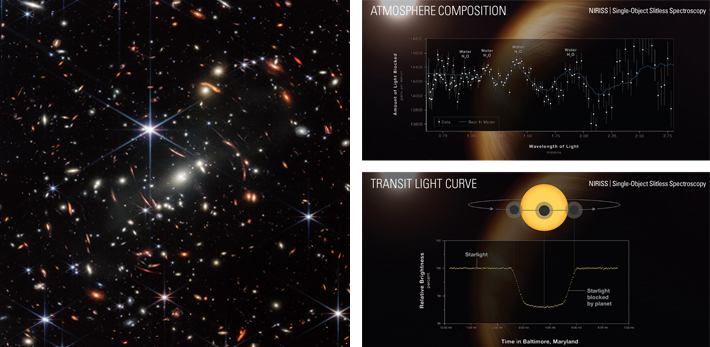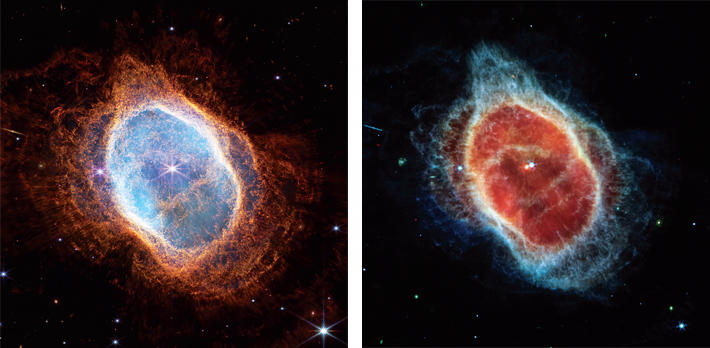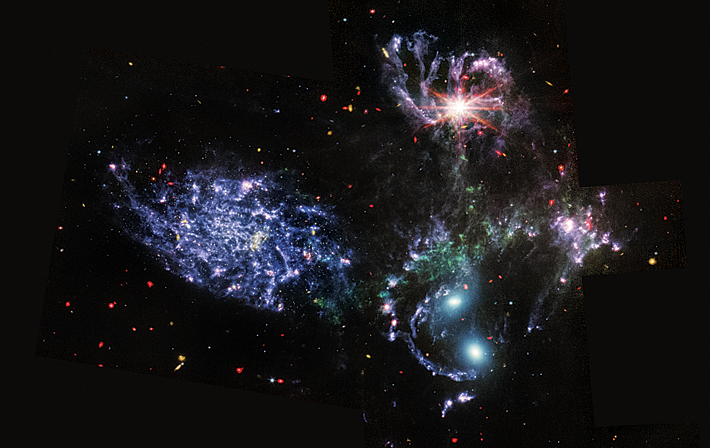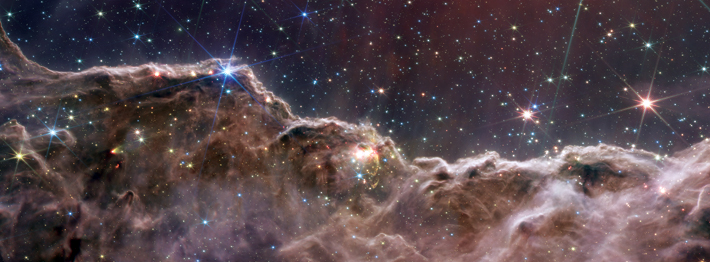INDIAN ARMED FORCES CHIEFS ON
OUR RELENTLESS AND FOCUSED PUBLISHING EFFORTS

SP Guide Publications puts forth a well compiled articulation of issues, pursuits and accomplishments of the Indian Army, over the years

I am confident that SP Guide Publications would continue to inform, inspire and influence.

My compliments to SP Guide Publications for informative and credible reportage on contemporary aerospace issues over the past six decades.
A Cosmic Treasure Trove Unfolded
On July 12, NASA unveiled the first batch of images from Webb’s data and the detailed view of the cosmic vistas, marking the dawn of a new era for astronomy

A space observatory that took more than twenty years to come to life is working in space one million miles away from the Earth to present us with the view of our universe like never seen before. The James Webb Space Telescope (JWST) which has been hailed as the largest, the most powerful and the most complex telescope ever built by humans was launched on December 25, 2021. Following a series of deployment and alignment of its mirrors and instruments over months, it has finally begun to send back data to Earth. On July 12, 2022, NASA (National Aeronautics & Space Administration) unveiled the first batch of images from Webb’s data and the detailed view of the cosmic vistas, marking the dawn of a new era for astronomy.
The images were a glimpse into the full capabilities of JWST, a partnership with ESA (European Space Agency) and CSA (Canadian Space Agency). The telescope’s first full-color images and spectroscopic data were released during a televised broadcast from NASA’s Goddard Space Flight Center.
These represented the first wave of full-color scientific images and spectra the observatory has gathered, and the official beginning of Webb’s general science operations. The first five targets were selected by an international committee of representatives from NASA, ESA, CSA, and the Space Telescope Science Institute.
Webb is on a mission to unfold the universe, capturing scenes from the earliest days of our universe’ formation and these initial images certainly displayed that capability. Webb aims to study every phase of 13.5 billion years of cosmic history - from within our solar system to the most distant observable galaxies in the early universe, and everything in between.
WEBB’S FIRST DEEP FIELD IMAGE: THE SHARPEST VIEW OF THE UNIVERSE
JWST has produced the deepest and sharpest infrared image of the distant universe to date. Known as Webb’s First Deep Field, this image is of galaxy cluster SMACS 0723. Thousands of galaxies – including the faintest objects ever observed in the infrared – have appeared in Webb’s view for the first time. This image was released a day earlier than the scheduled date by US President Joe Biden on July 11.
While we see thousands of galaxies covering almost every part of the image, this slice of the vast universe covers only a patch of sky approximately the size of a grain of sand held at arm’s length by someone on the ground. Some stars are also captured with prominent diffraction spikes, as they appear brighter at shorter wavelengths.
The combined mass of this galaxy cluster creates a sort of a cosmic magnifying glass, acting as a gravitational lens. This effect magnifies more distant galaxies, including some seen when the universe was less than a billion years old, and brings them into our view.
This image shows the galaxy cluster SMACS 0723 as it appeared 4.6 billion years ago, with many more galaxies in front of and behind the cluster. Much more about this cluster will be revealed as researchers begin digging into Webb’s data.
Light from these galaxies took billions of years to reach us. We are looking back in time to within a billion years after the big bang when viewing the youngest galaxies in this field. The light was stretched by the expansion of the universe to infrared wavelengths that Webb was designed to observe. Researchers will soon begin to learn more about the galaxies’ masses, ages, histories, and compositions.
This field was also imaged by Webb’s Mid-Infrared Instrument (MIRI), which observes mid-infrared light. Webb’s MIRI image offers a kaleidoscope of colors and highlights where the dust is – a major ingredient for star formation, and ultimately life itself. Webb’s NIRCam has brought distant galaxies into sharp focus – they have tiny, faint structures that have never been seen before, including star clusters and diffuse features.

(Right Top) A transmission spectrum reveals atmospheric characteristics of the hot gas giant exoplanet WASP-96 B; (Right Bottom) A light curve shows the change in brightness of light from the WASP-96 star system as the planet transits the star.
Webb’s Near Infrared Spectrograph (NIRSpec) microshutter array observed 48 individual galaxies at the same time – a new technology used for the first time in space – returning a full suite of details about each. The data revealed light from one galaxy that traveled for 13.1 billion years before Webb’s mirrors captured it. Webb’s Near-Infrared Imager and Slitless Spectrograph (NIRISS) used Wide-Field Slitless Spectroscopy to capture spectra of all the objects in the entire field of view at once. SMACS 0723 can be viewed near the constellation Volans in the southern sky.
WASP - 96B: AN EXOPLANET’S ATMOSPHERIC COMPOSITION
The first image revealed on July 12 was the spectra of an exoplanet’s atmosphere. JWST has captured the distinct signature of water, along with evidence for clouds and haze, in the atmosphere surrounding a hot, puffy gas giant planet orbiting a distant Sun-like star. This exoplanet (planet beyond our solar system) is Wasp-96b which is one of more than 5,000 confirmed exoplanets in the Milky Way. Located roughly 1,150 light-years away in the southern-sky constellation Phoenix, the planet represents a type of gas giant that has no direct analog in our solar system. With a mass less than half that of Jupiter and a diameter 1.2 times greater, WASP-96 b is much puffier than any planet orbiting our Sun. And with a temperature greater than 1000°F, it is significantly hotter. WASP-96 b orbits extremely close to its Sun-like star, just one-ninth of the distance between Mercury and the Sun, completing one circuit every 3½ Earthdays. The combination of large size, short orbital period, puffy atmosphere, and lack of contaminating light from objects nearby in the sky makes WASP-96 b an ideal target for atmospheric observations.
On June 21, Webb’s NIRISS measured light from the WASP-96 system for 6.4 hours as the planet moved across the star. The result is a light curve showing the overall dimming of starlight during the transit, and a transmission spectrum revealing the brightness change of individual wavelengths of infrared light between 0.6 and 2.8 microns.
While the light curve confirms properties of the planet that had already been determined from other observations – the existence, size, and orbit of the planet – the transmission spectrum reveals previously hidden details of the atmosphere: the unambiguous signature of water, indications of haze, and evidence of clouds that were thought not to exist based on prior observations. A transmission spectrum is made by comparing starlight filtered through a planet’s atmosphere as it moves across the star to the unfiltered starlight detected when the planet is beside the star. Researchers are able to detect and measure the abundances of key gases in a planet’s atmosphere based on the absorption pattern – the locations and heights of peaks on the graph. In the same way that people have distinctive fingerprints and DNA sequences, atoms and molecules have characteristic patterns of wavelengths that they absorb.
Researchers will be able to use the spectrum to measure the amount of water vapor in the atmosphere, constrain the abundance of various elements like carbon and oxygen, and estimate the temperature of the atmosphere with depth. They can then use this information to make inferences about the overall makeup of the planet, as well as how, when, and where it formed.
In addition, Webb’s extreme stability and its orbital location around Lagrange Point 2 roughly a million miles away from the contaminating effects of Earth’s atmosphere makes for an uninterrupted view and clean data that can be analysed relatively quickly. Over the coming year, researchers will use spectroscopy to analyse the surfaces and atmospheres of several dozen exoplanets, from small rocky planets to gas- and ice-rich giants. Studying exoplanets is one main feature of Webb. Nearly one-quarter of Webb’s Cycle 1 observation time is allocated to studying exoplanets and the materials that form them.
SOUTHERN RING NEBULA: A DYING STAR’S FINAL PERFORMANCE
This is a planetary nebula, exposing us to star death. Two stars, which are locked in a tight orbit, shape the local landscape. Hence, a binary star system is seen. The dimmer star at the center of this scene has been sending out rings of gas and dust for thousands of years in all directions, and JWST has revealed for the first time that this star is cloaked in dust. Two cameras aboard Webb captured the latest image of this planetary nebula, cataloged as NGC 3132, and known informally as the Southern Ring Nebula. Hence two images of the nebula were released; one in infrared and the other in mid-infrared. It is approximately 2,500 light-years away.
Webb’s infrared images feature new details in this complex system. The stars – and their layers of light – are prominent in the image. The brighter star is in an earlier stage of its stellar evolution and will probably eject its own planetary nebula in the future. Each shell represents an episode where the fainter star lost some of its mass. The widest shells of gas toward the outer areas of the image were ejected earlier. Those closest to the star are the most recent.

Webb will allow astronomers to dig into many more specifics about planetary nebulae like this one – clouds of gas and dust expelled by dying stars. This observation shows the Southern Ring Nebula almost face-on, but if we could rotate it to view it edge-on, its three-dimensional shape would more clearly look like two bowls placed together at the bottom, opening away from one another with a large hole at the center. Tracing these ejections allows researchers to look into the history of the system.
Since planetary nebulae exist for tens of thousands of years, observing the nebula is like watching a movie in exceptionally slow motion. Each shell the star puffed off gives researchers the ability to precisely measure the gas and dust that are present within it.
STEPHAN’S QUINTET: UNVEILING THE COSMIC DANCE
Stephan’s Quintet, is a visual grouping of five galaxies. This enormous mosaic is Webb’s largest image to date, covering about one-fifth of the Moon’s diameter. It contains over 150 million pixels and is constructed from almost 1,000 separate image files. The information from Webb provides new insights into how galactic interactions may have driven galaxy evolution in the early universe.
Sparkling clusters of millions of young stars and starburst regions of fresh star birth grace the image. Sweeping tails of gas, dust and stars are being pulled from several of the galaxies due to gravitational interactions. Most dramatically, Webb captures huge shock waves as one of the galaxies, NGC 7318B, smashes through the cluster.
Although called a “quintet,” only four of the galaxies are truly close together and caught up in a cosmic dance. The fifth and leftmost galaxy is well in the foreground residing 40 million light-years from Earth, while the other four galaxies are about 290 million light-years away. This is still fairly close in cosmic terms, compared with more distant galaxies billions of light-years away.
The data shows Webb’s ability to track solar system targets and produce images and spectra with unprecedented detail
This proximity provides astronomers a ringside seat for witnessing the merging and interactions between galaxies that are so crucial to all of galaxy evolution. Rarely do scientists see in so much detail how interacting galaxies trigger star formation in each other, and how the gas in these galaxies is being disturbed. Located in the constellation Pegasus, Stephan’s Quintet is being called a fantastic “laboratory” for studying these processes fundamental to all galaxies.

Tight groups like this may have been more common in the early universe when their superheated, infalling material may have fueled very energetic black holes called quasars. Even today, the topmost galaxy in the group harbors an active galactic nucleus, a supermassive black hole 24 million times the mass of the Sun. It is actively pulling in material and puts out light energy equivalent to 40 billion Suns. Webb also unveiled the molecules like iron, neon, sulphur, oxygen, etc. that are present around this black hole.
In the leftmost and closest galaxy, Webb was able to resolve individual stars and even the galaxy’s bright core. As a bonus, Webb revealed a vast sea of thousands of distant background galaxies reminiscent of Hubble’s Deep Fields. Webb studied the active galactic nucleus in great detail with the NIRSpec and MIRI. Combined with the most detailed infrared image ever of Stephan’s Quintet from MIRI and NIRCam, the data from Webb will provide a bounty of valuable, new information. For example, it will help scientists understand the rate at which supermassive black holes feed and grow.
CARINA NEBULA: UNCOVERING THE COSMIC CLIFFS
This is a literally star-studded image that is filled with stars all over, presenting the most beautiful view of a stellar nursery. This landscape of “mountains” and “valleys” speckled with glittering stars is actually the edge of a nearby, young, star-forming region called NGC 3324 in the Carina Nebula. Captured in infrared light by JWST, this image reveals for the first time previously invisible areas of star birth. Called the Cosmic Cliffs, Webb’s seemingly three-dimensional picture looks like craggy mountains on a moonlit evening. In reality, it is the edge of the giant, gaseous cavity within NGC 3324, and the tallest “peaks” in this image are about 7 lightyears high. The cavernous area has been carved from the nebula by the intense ultraviolet radiation and stellar winds from extremely massive, hot, young stars located in the center of the bubble, above the area shown in this image.
The blistering, ultraviolet radiation from the young stars is sculpting the nebula’s wall by slowly eroding it away. Dramatic pillars tower above the glowing wall of gas, resisting this radiation. The “steam” that appears to rise from the celestial “mountains” is actually hot, ionised gas and hot dust streaming away from the nebula due to the relentless radiation.

Webb reveals emerging stellar nurseries and individual stars that are completely hidden in visible-light pictures. Protostellar jets, which emerge clearly in this image, shoot out from some of these young stars. The youngest sources appear as red dots in the dark, dusty region of the cloud. Objects in the earliest, rapid phases of star formation are difficult to capture, but Webb’s extreme sensitivity, spatial resolution, and imaging capability can chronicle these elusive events. These observations will shed light on the process of star formation. Star birth propagates over time, triggered by the expansion of the eroding cavity. As the bright, ionised rim moves into the nebula, it slowly pushes into the gas and dust. If the rim encounters any unstable material, the increased pressure will trigger the material to collapse and form new stars. Conversely, this type of disturbance may also prevent star formation as the star-making material is eroded away. This is a very delicate balance between sparking star formation and stopping it.
Webb will address some of the great, open questions of modern astrophysics: What determines the number of stars that form in a certain region? Why do stars form with a certain mass? Webb will also reveal the impact of star formation on the evolution of gigantic clouds of gas and dust. Located roughly 7,600 light-years away, NGC 3324 was imaged by Webb’s NIRCam and MIRI.
FROM DISTANT DEPTHS TO COSMIC BACKYARD
With star forming regions, star births and star deaths in sight, thousands of galaxies and galaxy clusters, a sneak peak to the time when our universe was newly born, and scanning planets beyond our solar system, Webb’s data is a cosmic treasure trove. However, Webb is not just looking far away into the time acting like our time machine but will also be observing our own cosmic backyard i.e. our solar system. A continuous stream of data will now keep flowing from Webb’s fast and vast observations.
Among the recently commissioned early data are a couple of images of Jupiter and images and spectra of several asteroids, captured to test the telescope’s instruments before science operations officially began on July 12. The data demonstrates Webb’s ability to track solar system targets and produce images and spectra with unprecedented detail.

Jupiter’s images revealed familiar features of our solar system’s enormous planet in these images seen through Webb’s infrared gaze. A view from the NIRCam instrument’s short-wavelength filter shows distinct bands that encircle the planet as well as the Great Red Spot, a storm big enough to swallow the Earth. The iconic spot appears white in this image because of the way Webb’s infrared image was processed. At left Europa, a moon with a probable ocean below its thick icy crust, and the target of NASA’s forthcoming Europa Clipper mission is also visible. What’s more, Europa’s shadow can be seen to the left of the Great Red Spot. Other visible moons in these images include Thebe and Metis. Additionally, Webb easily captured some of Jupiter’s rings, which especially stand out in the NIRcam long-wavelength filter image.
“We have seen distant galaxies, as they were when the universe was less than a billion years old, and we’re just beginning the search. We have seen galaxies colliding and merging, revealing their chemical secrets. We have seen one black hole close up, in the nucleus of a nearby galaxy, and measured the material escaping from it. We’ve seen the debris when a star exploded, liberating the chemical elements that will build the next generations of stars and planets. We have started a search for Earth 2.0, by watching a planet transiting in front of its star, and measuring the molecules in its atmosphere,” said Webb senior project scientist John Mather.





